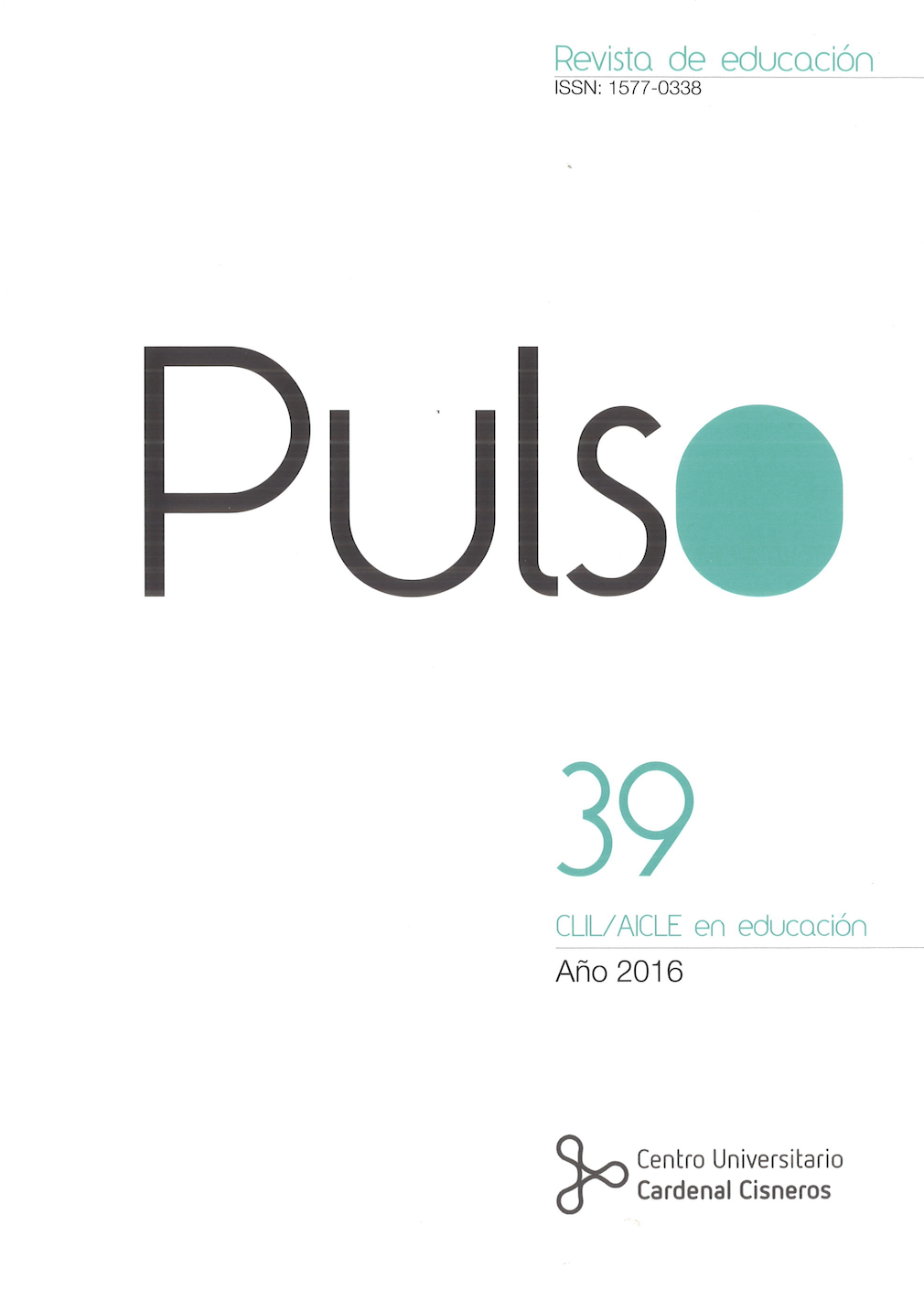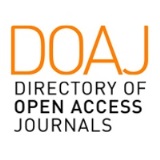Training primary student teachers for CLIL: innovation through collaboration
DOI:
https://doi.org/10.58265/pulso.5074Palabras clave:
Educación Biligüe, CLIL, Formación del Profesorado, Colaboración, PedagogíaResumen
El considerable aumento de los centros bilingües en España ha provocado una gran demanda de profesionales especializados. Como resultado, las universidades están comenzando a ofrecer titulaciones para formar al profesorado de centros bilingües. Normalmente se trata de estudios de Grado en los que el ámbito lingüístico ocupa un lugar preponderante pero que no suelen incluir una tención expresa a los principios metodológicos que animan y promueven la integración de lengua y contenido. Este tipo de formación debería cambiar el foco para centrarse en el desarrollo de las capacidades lingüísticas y también metodológicas del futuro profesorado bilingüe con el objetivo de formarlos convenientemente para estos contextos. En el presente estudio se analiza la puesta en marcha de una estructura de colaboración entre profesores universitarios y profesores experimentados de centros bilingües a través de datos obtenidos de las opiniones de profesorado de ambos niveles partipantes en el proyecto. Los resultados atestiguan los beneficios de incorporar al profesorado en activo en centros bilingües en la formación de los futuros profesores para este tipo de enseñanza.
Descargas
Citas
Ball, P., Lindsay, D. (2010). Teacher training for CLIL in the Basque Country: The case of the Ikastolas - An expediency model. In D. Lasagabaster and Y. Ruiz de Zarobe (Eds.). CLIL in Spain: Implementation, Results and Teacher Training (pp. 162-187). Newcastle upon Tyne: Cambridge Scholars Publishing.
Banegas, D. L. (2015). Sharing views of CLIL lesson planning in language teacher education. Latin American Journal of Content and Language Integrated Learning, 8 (2), 104-130. DOI:10.5294/laclil.2015.8.2.3.
Bertaux, P., C.M. Coonan, M.J. Frigols, Mehisto, P. (2010). The CLIL Teacher’s Competence Grid. Retrieved from: http://lendtrento.eu/convegno/files/mehisto.pdf
Bonnet. A. (2012). Language, content and interaction: how to make CLIL classroom work. In D. Marsh and O. Meyer (eds.), Quality Interfaces: Examining Evidence & Exploring Solutions in CLIL (pp. 172-189). Eichstätt: Eichstätt Academic Press.
Breeze, R., Llamas, C., Martínez Pasamar, C., Tabernero, C. (2014). Integration of Theory and Practice in CLIL. Amsterdam: Rodopi.
British Council (2015). Formación inicial para profesores bilingües en ingles: políticas, practices y recomendaciones. Alcalá de Henares: British Council-Universidad de Alcalá de Henares. Retrieved from: http://www.cardenalcisneros.es/es/articulo/la-universidad-alcalá-y-british-council-publican-las-conclusiones-del-congreso-formación#.V1KMxVd2nqo
Cammarata, L., Tedick, D. (2012). Balancing content and language instruction. The experienced immersion teachers. The Modern Language Journal, 96 (2), 251-269.
Cenoz, J. (2013). Discussion: towards an educational perspective in CLIL language policy and pedagogical practice. International Journal of Bilingual Education and Bilingualism, 16 (3), 389-394.
Cenoz, J. (2015). Content-based instruction and content and language integrated learning: the same or different?. Language, Culture and Curriculum, 28, 8-24.
Cenoz, J., F. Genesee, F., Gorter, D. (2013). Critical analysis of CLIL: taking stock and looking forward. Applied Linguistics (advance access), 1-21. Retrieved from: http://applij. oxofrdjournals.org/.
Consejería de Educación, Comunidad de Madrid (2010). Los programas de enseñanza bilingüe en la Comunidad de Madrid: un studio comparado. Madrid: Consejería de Educación, Consejo Escolar.
Coyle, D. (2007). Content and Language Integrated Learning: Towards a Connected Research Agenda for CLIL Pedagogies, The International Journal of Bilingual Education and Bilingualism, 10 (5), 543-562.
Coyle, D. (2013). Listening to learners: an investigation into ‘successful learning’ across CLIL contexts, in International Journal of Bilingual Education and Bilingualism, 16 (3), 244-266.
Dafouz, E. (2015). Más allá del inglés: la competencia lingüística multi-dimensional como estrategia para la enseñanza en la Universidad internacional. Educación y Futuro, 32 (special issue on Bilingualism and Teacher Training), 15-34.
Dafouz, E., Guerrini, M. (eds.) (2009). CLIL Across Educational Levels: Experiences from Primary, Secondary and Tertiary Contexts. Madrid: Santillana.
Dafouz, E., Núñez, B. (2009). CLIL in higher education: devising a new learning landscape” In E. Dafouz and M. Guerrini (eds.), CLIL Across Educational Levels: Experiences from Primary, Secondary and Tertiary Contexts (pp. 101-112). Madrid: Santillana.
Delicado Puerto, G., Pavón, V. (2015). La implantación de titulaciones bilingües en la educación superior: el caso de la formación didáctica del profesorado bilingüe de Primaria en la Universidad de Extremadura. Educación y Futuro, 32, 35-63.
Dobson, A., Pérez, M., Johnstone, R. (2010). Bilingual Education Project (Spain): Evaluation Report. Madrid: Ministerio de Educación-British Council.
Escobar, C. (2010). Student CLIL teacher education in Catalonia. Expert and novice teachers teaching together. In D. Lasagabaster and Y. Ruiz de Zarobe (Eds.). CLIL in Spain: Implementation, Results and Teacher Training (pp. 188-218). Newcastle upon Tyne: Cambridge Scholars Publishing.
Escobar, C. (2013). Learning to become a CLIL teacher: teaching, reflection and professional development. International Journal of Bilingualism and Bilingual Education, 16 (3), 334-353.
Escobar, C., Pérez-Vidal, C. (2004). Teacher education for the implementation of a content and language integrated approach (CLIL) in the school system. In R. Wilkinson (ed.), Integrating content and language. Meeting the challenge of a multilingual higher education (pp. 402-415). Maastricht: Maastricht University.
García, R. (2015). CLIL teacher training in Europe. Educación y Futuro, 32 (special issue on Bilingualism and Teacher Training), 65-82.
González, J.A., Barbero, J. (2013). Building bridges between different levels of education: Methodological proposal for CLIL at university, Language Value 5, 1, 1-23.
Halbach, A. (2009). The primary school teacher and the challenges of bilingual education. In E. Dafouz and M. C. Guerrini (Eds.), CLIL across educational levels: experiences from primary, secondary and tertiary contexts (pp. 19-26). Madrid: Richmond Publishing.
Halbach, A. (2010). From the classroom to university and back: teacher training for CLIL in Spain at the Universidad de Alcalá. In D. Lasagabaster and Y. Ruiz de Zarobe (Eds.). CLIL in Spain: Implementation, Results and Teacher Training (pp. 243-256). Newcastle upon Tyne: Cambridge Scholars Publishing.
Hansen-Pauly, M.A., Bentner, G., Jovanovic, V., Zerbato, D., Llinares, A., Dafouz, E., Erades, C, García, M. Carreras, A., Favili, F., Dale, L., Robinson, P, Hoffmanova, M., Novotna, J. (2009). Teacher education for CLIL across contexts: From scaffolding framework to teacher portfolio for content and language integrated learning. Retrieved from http://clil.uni.lu
Hillyard, S. (2011). First steps in CLIL: Training the teachers. Latin American Journal of Content & Language Integrated Learning, 4, (2). 1-12. DOI:10.5294/laclil.2011.4.2.1 ISSN 2011-6721
Horrillo, Z. (2011). Formación del profesorado en el enfoque AICLE: apreciaciones informadas de la didáctica de las materias en las que el otro es experto. Un estudio de caso. In C. Escobar, N. Evnitskaya, E. Moore and Patiño, A. (Eds.), AICLE-CLIL-EMILE: Educació plurilingüe (pp. 41-56). Barcelona: Servicio de Publicaciones de la Universidad Autónoma de Barcelona.
Hunt, M., Neofitou, A., Redford, J. (2009). Developing CLIL training for modern language teachers trainees. In D. Marsh, P. Mehisto, D. Wolff, R. Aliaga, T. Asikainen, M.J. Frigols and S. Hughes (Eds.), CLIL Practice: Perspectives from the Field (pp. 110-116). Jyväskylä: University of Jyväskylä.
Hüttner, J., Dalton-Puffer, C., Smit, U. (2013). The power of beliefs: lay theories and their influence on the implementation of CLIL programmes. International Journal of Bilingual Education and Bilingualism, 16 (3), 267-284.
Infante, D., Benvenuto, G., Lastrucci, E. (2009). The effects of CLIL from the perspective of experienced teachers. In D. Marsh, P. Mehisto, D. Wolff, R. Aliaga, T. Asikainen, M.J. Frigols, S. Hughes and G. Langé (Eds.). CLIL Perspectives from the Field (pp. 156163). Jyväskylä: University of Jyväskylä.
Laorden, C., Peñafiel, E. (2010). Proyectos bilingües en los centros de la Comunidad de Madrid: percepción de los equipos directivos. Revista de Investigación Educativa, 28 (2). 325-344.
Lasagabaster, D., Ruiz de Zarobe, Y. (eds.) (2010). CLIL in Spain. Implementation, Results and Teacher Training. Newcastle upon Tyne: Cambridge Scholars Publishing.
Lasagabaster, D., Sierra, J.M. (2010). Immersion and CLIL in English: more differences than similarities. ELT Journal, 64 (4), 367-375.
Lorenzo, F. (2002). Stages in content-based instruction course development in English teaching at tertiary level. In A. Bueno, G. Tejada, G. Luque (eds.), Las Lenguas en un Mundo Global. XX Congreso Nacional de AESLA (pp. 179-191). Universidad de Jaén.
Lorenzo, F., Casal, S., and Moore, P. (2009). The effects of Content and Language Integrated Learning in European education: key findings from the Andalusian bilingual sections evaluation project. Applied Linguistics, 31 (3), 418–442.
Lorenzo, F. (2010). CLIL in Andalusia. In D. Lasagabaster and Y. Ruiz de Zarobe (Eds.), CLIL in Spain. Implementation, Results and Teacher Training (pp. 2-27). Newcastle upon Tyne: Cambridge Scholars Publishing, . Madrid, M., Madrid, D. (2014). La formación inicial del profesorado para la educación bilingüe. Granada: Universidad de Granada.
Marsh, D. (2002). Content and Language Integrated Learning. The European Dimension. Jyväskyla: University of Jyväskyla Press.
Marsh, D., Pavón, V., Frigols, M.J. (2013). The Higher Education Languages Landscape: Ensuring Quality in English Language Degree Programmes. Valencia: Valencian International University.
Melara, F. (2013). Creating a profile of competences for Primary Education teachers specializing in CLIL. Unpublished Master’s Thesis Dissertation. University of Córdoba.
Mehisto, P., Genesee, F. (Eds.) (2015). Building Bilingual Education Systems: Forces, Mechanisms and Counterweights. Cambridge: Cambridge University Press.
Meyer, O. (2010). Towards Quality-CLIL: Successful Planning and Teaching Strategies, Pulso, 33, 11-29.
Moliner, M. (2013). The effects of CLIL from the perspective of in-service teachers in Salamanca (Castilla y León, Spain). Educaçao y Formaçao, 8, 200-217.
Olivares, M., Pena, C. (2013). How do we train our CLIL teachers? A case study from Alcalá University. Porta Linguarum, 19, 87-99.
Pavón, V., Gaustad, M. (2013). Designing Bilingual Programmes for Higher Education in Spain: organizational, curricular and methodological decisions. International CLIL Research Journal, 1 (5). 82-94.
Pavón, V., Ellison, M. (2013). Examining teacher roles and competences in Content and Language Integrated Learning (CLIL). Linguarum Arena, 4, 65-78.
Perez Cañado, M.L. (2014). Teacher training needs for bilingual education: in-service teacher perceptions. International Journal of Bilingual Education and Bilingualism, 1-30 (advance access). DOI: 10.1080/13670050.2014.980778
Perez Cañado, M.L. (2015). La formacion del profesorado para la enseñanza bilingue: pasado, presente y futuro. In Formación inicial para profesores de programas bilingues en ingles: politicas, practicas y recomendaciones, report conducted by the British Council and the University of Alcala. Retrieved from: http://www.cardenalcisneros.es/ sites/default/files/Seminario%20Formación%20Inicial%202015.pdf
Pérez Invernón, A. (2012). Evaluación de programas bilingües: análisis de resultados de las secciones experimentales de francés en el marco del Plan de Fomento de Plurilingüismo de la Junta de Andalucía. PhD. Dissertation. University of Córdoba, Spain.
Pérez -Vidal, C. Escobar, C. (2004). Teacher education for the implementation of CLIL in the school system. In B. Wilkinson (Ed.), Integrating Content and Language. Meeting the Challenge of a Multilingual Higher Education (pp. 389-402). Netherlands: Maastricht University.
Pladevall-Ballester, E. (2014). Exploring primary school CLIL perceptions in Catalonia: students’, teachers’ and parents’ opinions and expectations. International Journal of Bilingual Education and Bilingualism, 1-15 (advance access). DOI: 10.1080/13670050.2013.874972
Ramos, F. (2007). Programas bilingües y formación de profesores en Andalucía. Revista Iberoamericana de Educación, 44, 133-146.
Ramos, A.M. (2013). Higher Education Bilingual Programmes in Spain. Porta Linguarum, 19, 101-111.
Salaberri, M.S. (2010). Teacher Training Programmes for CLIL in Andalusia. In D. Lasagabaster and Y. Ruiz de Zarobe (eds.), CLIL in Spain. Implementation, Results and Teacher Training (pp. 140-159). Newcastle upon Tyne: Cambridge Scholars Publishing.
San Isidro, X. (2008). O desenvolvemento da competencia plurilingüe entre as prioridades da Administración educativa galega. EDUGA, 53, 30-31.
Sierra, L., López, A. (2015a). Presentación, Educación y Futuro, 32 (special issue on Bilingualism and Teacher Training), 9-12.
Sierra, L., López, A. (2015b). CLIL en la formación inicial del profesorado de educación Infantil y primaria, Educación y Futuro, 32 (special issue on Bilingualism and Teacher Training), 83-114.
Woodward, T. (1986). Loop input-a process idea. The Teacher Trainer, 1, 6-7.
Descargas
Publicado
Cómo citar
Número
Sección
Licencia
Derechos de autor 2022 Pulso. Revista de educación

Esta obra está bajo una licencia internacional Creative Commons Reconocimiento-NoComercial-SinObraDerivada 3.0.
Esta revista proporciona un acceso abierto inmediato a su contenido, basado en el principio de que ofrecer al público un acceso libre a las investigaciones ayuda a un mayor intercambio global de conocimiento.
Las obras se publican en la edición electrónica de la revista bajo una licencia Creative Commons Reconocimiento-NoComercial-SinObraDerivada 4.0
Se permite y se anima a los autores a difundir electrónicamente la versión post-print (versión evaluada y aceptada para su publicación) de sus obras antes de su publicación, ya que favorece su circulación y difusión más temprana y con ello un posible aumento en su citación y alcance entre la comunidad académica.














